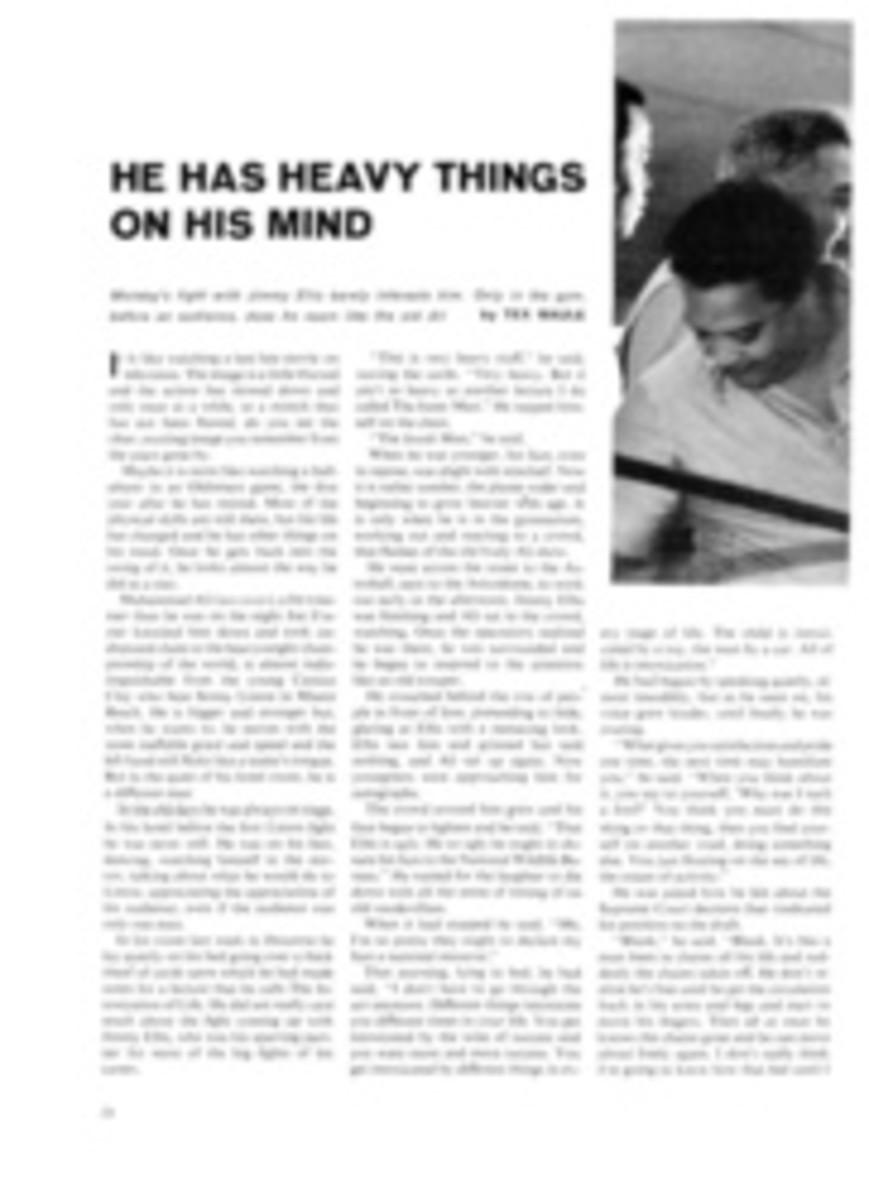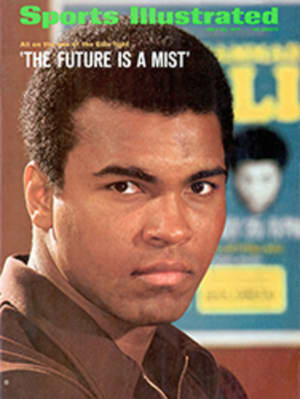
Hats off at the comeback of an old renegade
When Luis MiguelDominguín, age 45, came out of his 10-year retirement recently to face bulls atLas Palmas, Canary Islands, the press of the Spanish-speaking world could beexcused for palpitating. He was described, generously and inaccurately, as theworld's greatest bullfighter, while the public was treated to a rehash of hislife and loves as though he were Howard Hughes or someone really interesting.At the same time, the press ignored the fact that Antonio Bienvenida (AntonioMejías Jiménez), age 49, came out of retirement this season not in theprovinces but in two corridas at the important fair of San Isidro inMadrid.
Dominguín istall, aristocratic in appearance, a fine torero, wealthy, an associate ofPicasso and dear friend of a succession of beautiful and famous women. He isglamorous. Before his retirement, he regularly appeared in 70 to 100 corridas ayear with the best matadors of his generation. Bienvenida is a great torerowho, in comparison, looks like a cross between Sancho Panza and Richard MilhousNixon. Bienvenida is still married to his first wife and is the father of fourchildren. In his most successful year as a matador, 1948, he appeared in only53 corridas. When he retired in 1966, he fell back not into the arms of the jetset, but to a Chrysler dealership and to proprietorship of a bar in Madrid.
It is not newsthat appearances often mislead, and in no case more totally than inBienvenida's Dominguín's choice of Las Palmas for his return, with inferiorbulls, compared to Bienvenida's appearances in Madrid with 5-year-old Spanishand Portuguese bulls, is a case in point. This is not to denigrate Dominguínbut to focus attention where. in the eyes of real bullfighting, it belongs. Forwhat happened was this: Antonio Bienvenida sacrificed the glamour and pesetasthat his talent would have ensured him in order to buck the system at a timewhen his rich and glamorous contemporaries chose to profit fromskullduggery.
During theSpanish Civil War of 1936-39, the herds of fighting bulls were slaughteredindiscriminately, either for food or for political vengeance upon landowners.As a result, the herds had to be reconstituted when the war officially ended. Ageneration of toreros, accordingly, was brought up to face poorly bred, scrawnyanimals. By the late 1940s, when the bloodlines had been reestablished and goodanimals were again becoming available, all hands had become accustomed to slackstandards. Breeders, impresarios and managers conspired in various crookedpractices that impaired the bull's accuracy and timing. Horn shaving was themost common: the removal of the tip of the horn, followed by filing the baseinto a new tip. By 1952, horn shaving had become a national scandal, widelyknown but never admitted. When all seemed lost, a group of breeders publiclydenounced horn shaving, while one torero and only one, Antonio Bienvenida,confessed in a radio broadcast that, although like all the rest he had facedshaved horns in the past, he would do so no longer.
The public wasdelighted, but not one of Bienvenida's fellow toreros so much as commented onhis statement Some were conspicuous by their absence from Spain for the nextseason or two, while in 1953 six of the leading toreros took part in a boycott,refusing to appear on the same card with Bienvenida. There were several timesafter that when Bienvenida had to face six bulls on a program when otherscheduled toreros mysteriously failed to show In 1954 he was excluded from boththe Easter feria in Seville and from San Isidro.
It was to SanIsidro, the big fair in the capital, that Bienvenida made his return this year,working with another fine veteran, Andrés Vàzquez, first with an imposingstring of bulls of Samuel Flores, and on the last day of the fair with threePortuguese and three Spanish bulls from six different ranches, all mature,well-horned creatures.
In Bienvenida's30 years as torero, the bulls have given him 14 serious gorings and the priestshave twice given him the sacrament of Extreme Unction. Antonio's followers knewthat he had never been came de toro (bull meat). His wounds were not the resultof stupidity; they were always from accidents: an evil wind blowing a cape, arare miscalculation, a determination to dominate a bull, goring or not.
Because of hisservices to bullfighting, and because he was a master torero and senor,Bienvenida had been missed in recent seasons. Yet dread salted the publicanticipation of his return. Bienvenida, it was felt, might do better to standupon an honorable past and not risk another goring or undignified hoots from analways pitiless public.
Spain is a noisycountry. The Spanish prattle like birds, and at a corrida they shout advice,insults or encouragement to the men in the ring. But when Bienvenida, inpelting rain, faced his first bull, there was incredible, unprecedentedsilence, and it continued throughout most of the afternoon—tribute to what thetoreros were about.
Bienvenida showedthat he had not lost the art of apparent naturalness before the bull; as heforced the animal to pass, his happy smile disguised from all but trulyknowledgeable fans a precise assessment of the skill of distances and anintelligent awareness of what was needed to bring about the fullest estheticeffect from the bull. His cape work was slow and elegant as he showed youngaficionados muleta passes they had never seen outside books. Most moderntoreros have learned to work only with the muleta held low; if the bull doesnot respond, they do not know quite what to do. Bienvenida demonstrated how todominate a stubborn bull with two-handed passes given high, passes not seensince the days of Domingo Ortega. Antonio's tour of the ring after killing hisfirst bull released all the pent-up noise in the stands.
In the 11 daysbetween Bienvenida's reappearance and his scheduled mano a mano with AndrésVàzquez on the final day of the fair, it was remarkable to hear even old crockswho haven't liked anything since 1912 singing the praises of Bienvenida. Stillthere was apprehension, for Antonio and Andrés were to take on six large,dirty-looking, splendid beasts, a concurso from six Portuguese and Spanishranches. It was possible that Antonio could not repeat his performance, that hestill was signing up for more than his age warranted. But if all went well,this could be one of the corridas of the decade. Here were two absolutelyhonest, unquestioned masters, with the courage and technical resources to facebulls that would have produced instant gastroenteritis in the bellies of mostof the classy stars of today.
To a full house,in sunshine for once, the corrida unfolded surprisingly, gloriously forBienvenida but miserably for Vàzquez. It was the younger man who made the errorand took a nasty wound in his left armpit. Bienvenida thus had to kill fivebulls, not three, and now it was the Madrid public's turn to receive animpressive demonstration of classical bullfighting. The strength and caste ofthe bulls may be judged from the fact that among them they took 21 pics, thisat a time when six bulls rarely take more than eight or 10 pics altogether. Allthe bulls were difficult and dangerous, yet both men executed grand verónicas,stepping into the line of charge and following through. Bienvenida placed thebulls exactly where they needed to be in order to counteract their badtendencies and encourage them to charge. His muleta work was so exact and gaythat it tended to disguise the danger. Vàzquez' goring underlined that dangerfully, giving Bienvenida's faenas to his last two bulls a depth and seriousnessbordering on the terrible melancholy that the finest bullfighting alwaysproduces. By the end of that afternoon the fat, short, middle-aged man hadbecome tall and aristocratic. Juan Carlos, the next ruler of Spain, acclaimedBienvenida "torero" along with 20,000 other people. He had provedhimself foremost among the 29 matadors who took part in the fair of San Isidro,1971.
Dominguín isreported to have said, with his customary charm, that he came back to theplazas because he was "in search of an illusion—total happiness."Bienvenida, on the first two afternoons of his return, gave the public thereality, not the illusion. May both men come to share it in the seasonsahead.
PHOTO

